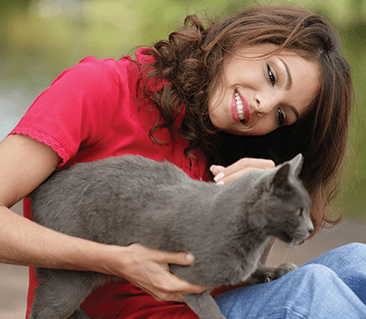James R. Speiser, DVM, DABVP, CCRT
October 16, 2015
Unfortunately we all experience changes in our body as we age, and for cats, there’s no exception. But cats are notorious for masking symptoms of disease, so it’s important to take action if you suspect something may be a little off, rather than waiting to see if it gets better on its own.
Common health issues we see in older cats include kidney disease, cancer, diabetes, and hyperthyroidism. Here are some symptoms to look out for:
- Kidney disease. You’ll find that cats with kidney disease drink more water, or urinate more than usual. You also might notice weight loss, bad breath, or ulcers in the mouth in extreme cases. Kidney disease can be treated with dietary change and medications. Some cats will require intravenous fluid therapy in the hospital for a few days, followed by fluids given at home by the owner 2-3 times a week.
- Cancer. Lymphosarcoma is one of the most common cancers found in cats. Symptoms vary based on what organ is affected – liver, intestine, kidney, lung, skin, lymph node, or brain, but warning signs often include weight loss, lethargy, and anorexia. If the cancer involves the digestive system (the most common form), the cat will vomit. In the lung, they’ll experience difficulty with breathing, which can become an emergency. With liver cancer, they might become jaundice (turn yellow), and with brain cancer, they could have seizures, become disoriented, have a head tilt, or walk in circles. Lymphosarcoma can be treated with chemotherapy and can be quite successful for 6-18 months, depending on the site and nature of the cancer. This time period may not seem long to us, but relative to how long a cat typically lives (around 12 years), 12 months would be like you living an additional 6+ years with successful treatment!
- Diabetes. You’ll find that diabetic cats are really thirsty, urinate more often, and appear thinner. Type 1 diabetes is when the pancreas cannot make enough insulin due to a degenerative change where the cells that make insulin die and do not regenerate. This type can be treated successfully with insulin injections that the owner will need to give twice a day, along with a specific diet. Type 2 diabetes is when the cells in the pancreas don’t make enough insulin due to a competitive factor or medication that the cat has been given (like corticosteroids, for instance). An oral medication can help control the diabetes without the need for insulin. In general, obese cats have a much higher risk of diabetes, so weight loss is important, as long as it’s gradual.
- Hyperthyroidism. Hyperthyroid cats will have a ravenous appetite, but experience excessive weight loss. Their coat will look unkempt, and eventually they will get anorexic. Hyperthyroidism also causes high blood pressure, which over time can cause chronic irreversible kidney disease, which can then cause a stroke. It can be diagnosed with a simple blood test and treated with a single shot cure of Iodine 131, which eliminates having to give a pill twice daily.
The best preventative is to keep your cat at a healthy weight, and order blood work when you visit your vet once a year. Comparatively, if you were over 60 years old, would you feel comfortable getting a health check once every 7-10 years? Probably not!

